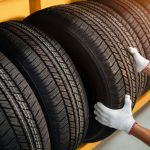How Tire Tread Patterns Affect Traction and Handling

Why Good Treads are Necessary
Tires with worn-out treads can be a safety hazard on the road. Treads are designed to provide grip and traction, especially in wet, snowy, or icy conditions. As the tire rolls, the treads effectively channel water, snow, and debris away from the contact patch between the tire and the road. This helps maintain better contact with the road surface, reducing the risk of hydroplaning and improving overall handling and braking performance.
Checking Your Tires
Regularly checking your tire treads is essential to ensure optimal safety on the road. Here’s a simple method to check:
1. Penny Test: Take a penny and insert it into the tread grooves with Lincoln’s head facing downward. If the top of Lincoln’s head is visible, it indicates that the tread depth is too shallow and it’s time to replace the tires. On the other hand, if the entire head is covered by the tread, it’s a good indication that your tire treads are still in good condition.
Tire Tread Patterns and Their Effects
Tire tread patterns come in various designs, each with its own purpose and effects on the vehicle’s traction and handling. Here are a few common tread patterns and how they affect your driving experience:
1. Symmetrical Tread Patterns: These treads feature continuous ribs across the entire tread width. They are designed for all-season use and provide good traction on both wet and dry surfaces. Symmetrical tread patterns deliver a smooth and comfortable ride, with predictable handling characteristics.
2. Asymmetrical Tread Patterns: Asymmetrical treads have different patterns on the inner and outer sides of the tire. This design helps optimize performance in different driving conditions. The inner side often has deeper grooves for better water evacuation, while the outer side provides improved dry traction and cornering stability.
3. Directional Tread Patterns: Directional treads have v-shaped grooves that point in one direction. This design helps to effectively channel water outwards, allowing for better traction on wet surfaces. Additionally, directional treads typically have large blocks or independent tread elements that enhance traction and handling performance.
4. Winter Tread Patterns: Winter or snow tires have specially designed tread patterns that provide enhanced traction in snowy conditions. These treads feature more aggressive patterns with deeper grooves and biting edges. They are optimized for gripping snow and providing better traction on icy or slippery roads.
Effects on Traction and Handling
Having the right tread pattern on your tires significantly affects the traction and handling of your vehicle. Here’s how:
1. Traction: The primary purpose of tire treads is to provide traction. The grooves and patterns help the tire maintain contact with the road surface, even in adverse conditions. This improved traction helps with acceleration, braking, and cornering, ensuring better control and reducing the risk of skidding or sliding.
2. Handling: Tire treads play a crucial role in handling performance. The patterns provide stability and grip, allowing for better control and maneuverability. Different tread patterns are designed to optimize traction during different types of driving, such as highway driving, off-roading, or winter conditions. The right tread pattern can make a significant difference in how your vehicle responds to steering inputs and maintains stability in various driving situations.
Summary
Tire tread patterns are more than just aesthetics – they are a critical component of your vehicle’s safety and performance. Regularly checking your tire treads and replacing worn-out tires is essential for optimal traction and handling. Understanding the different types of tread patterns and their effects will help you make informed decisions when purchasing new tires. So, take the time to ensure your tires have good treads, and enjoy a safer and more enjoyable driving experience.
Need a Mechanic in Lubbock, TX?
Since 1975, M & M Tire and Service Center has been the premier provider of general automotive repairs in the Lubbock area. We are a family-owned and operated business with over 40 years of experience. Our friendly and professional staff work to provide quality repairs and services at reasonable prices. At M & M Tire and Service Center, we offer oil changes, brake servicing, suspension repair, tires, electrical system analysis, heating and air conditioning, engine repairs, doors and windows and safety inspections. Call us today to schedule your next appointment and see why the Better Business Bureau has given us an A+ rating since 1983.
More...
Categorised in: Tire Replacement, Tire Tips
This post was written by admin





